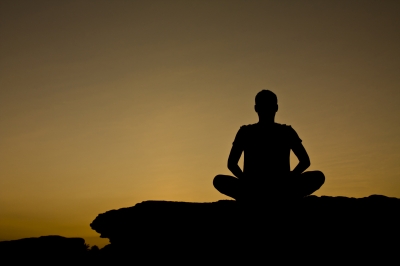Use Meditation in Everyday Life
When we think about meditation or mindfulness, it’s easy to get caught-up in the belief that we need to be sitting on a cushion, cross-legged, or located within a monastery to practice meditation.
While these aspects of meditation can provide us with the support necessary to achieve a stable meditation practice, and while a formal meditation practice is the only way to become familiar with our mind, the primary reason to meditate, especially within the context of caring for another, is to become familiar with our true nature within our ordinary daily life.
In fact, the “deeper” nature of our mind is quite ordinary, that is, a mind unencumbered with the immense distraction of our habitual tendency of being distracted, while the distracted, preoccupied mind that we think of as normal is quite extraordinary.
Mindfulness and meditation are not a some “thing” to be found outside of the context of our daily lives, they’re not something to be practiced away from our lives. While it is very important that we establish a daily meditation or mindfulness practice that is more “formal,” it is the extraordinary sense of presence that we achieve during our day that brings us deeply in touch with our compassionate and attentive mind.
How To Use Meditation In Your Daily Activities
The following is a very short list of some of the opportunities that we can use to check-in with our mind during the day. While far from extensive, this list can act as a reminder to us that there are unlimited moments within our day when we can take a “time out” from our distraction and attend to our mind.
1. While taking a shower
2. While brushing your teeth
3. While eating
4. While eating…did I say this twice? Right, how many of us rush through our meals without even remembering what it was that we ate? Eating is one of the best times to practice being mindful and aware. It’s amazing how our food intake, what we take into our body, how much we eat, and—surprise!—how much we gain weight can be due to not being present with what we’re eating. Try it! You have three times a day to work with this one.
5. While driving to: work, school, play, shop, run errands, vacations, distraction.
6. While surfing the web or being otherwise involved on the computer. Who knows, you may be less inclined to impulse-buy on the Internet.
7. While exercising. This is a great one. I used to run a lot—marathons, 10k, etc. I also still like to bicycle quite a bit. But how to find the time to practice when I want to bike? Exactly; practice while biking. This means seeing my surroundings, feeling the road, smelling the smells, feeling my heart pounding, noticing the patterns of my breathing. Zen and the art of biking!
8. While at work. Right, this is why we’re learning about this, isn’t it? What about when you’re taking care of someone who is being difficult? Or who’s dying? Or who’s unconscious on a ventilator? Or who’s giving birth? What about when your boss is telling you that you need to work harder? Or less hard? Or maybe you’re the boss? Right. Work.
9. Stuck at a traffic light? Meditate. But don’t forget to be aware of the light. This isn’t about spacing out, remember? Gee; what are those cars behind me honking at me for? I’m at one with the light…except that it’s green!
10. Folding laundry.
11. Doing the dishes. I love this one. As a kid, my mom figured out early on that kids were valuable…for doing the dishes. I think that I became a Zen dishwasher at the age of 10!
12. When you’re sick.
13. When you’re in pain.
14. When you’re sad or when you’re happy.
15. As you’re going to sleep at night, having set aside the cares of the day, bring your attention to your mind and just relax into an undistracted state of mind.
16. The first thing in the morning, as you’re arising, see what your mind is like before it’s become preoccupied and distracted with the day’s to-do list.
17. And the list goes on and on. Truly, since we’re trying to become more present and less distracted at any and all moments, there’s never a time where practicing won’t work. Try it.
To end this post, daily integration – as in the list above – is not a substitute for a formal practice. Formal means that we take the time to set aside time each day to practice mindfulness and meditation in an unhurried and quiet space. The point of this article is to remind us that we also have each moment of every day to practice and to reinforce the practice that we have spent “on the cushion” and that it is in our daily “ordinary” practice that we have the chance to see how our formal practice is going.
How To Meditate
Maybe you’ve already got a meditation practice. If that’s the case, great! Keep it up. And feel free to use all of the content from this site to support you in your efforts. If you haven’t started to meditate, begin now.
Many people don’t meditate because they believe that they need to do “something special” in order to meditate, maybe you’re one of them. “Doing something” special isn’t the case. All you need is your breath, and a few minutes of time set aside to begin your practice. Here are some tools to get you started:
- Meditation audio for using your breath as the anchor of your attention during meditation.
- Ebook and two chapters from the book, Minding the Bedside: Nursing from the Heart of the Awakened Mind, on how to meditate.
- Even though my book was written with nurses in mind, I continue to get feedback from those who have bought it who aren’t nurses that they find it useful in their lives. So, check out the book, Minding the Bedside: Nursing from the Heart of the Awakened Mind. It’s really written for anyone. You can even buy it in a Kindle version!
This site has tons of tools for learning how to meditate.
I encourage you to look through the HUNDREDS of articles that I’ve written and especially check out my weekly meditation tips and other useful meditation materials provided for your health and well being. And please let me know if you’d like to discuss anything with me, have any questions or need clarification regarding anything that I’ve written about.
Thanks for visiting and have a mindful day.
Images: renjith krishnan / markuso /FreeDigitalPhotos.net



[…] 17 Ways to Practice Mindfulness Meditation in Everyday Life […]
[…] having to think about it, we breathe, and because we’re always breathing, we can use our breath anytime and anywhere as an object of focus, bringing ourselves into the present moment, and calming the distracted […]
[…] everyday life, to make it easier to integrate your meditation practice into all you do, check out this link. Also, there have previous posts on this blog about the scientific research into meditation and […]
[…] formal practice. While there are ways of integrating practice into our daily life (also see post: 17 Ways to Practice Mindfulness Meditation in Everyday Life) it’s important to remember that we need to set aside time for ourselves each day, apart from […]
[…] nature can take time. But, you’ve got time, right? I’ve written a lot on how to use daily activities to practice meditation. And I’ve also written about the need to have a formal practice as […]
[…] may have already read one of the posts on how you can integrate meditation into daily life, or maybe you’ve downloaded the PDF document on how to use different activities in your life […]
[…] For a real cool PDF with more ideas on how to use spare time in your life to practice meditation, check out: 17 Ways to Practice Mindfulness Meditation in Everyday Life. […]
[…] a previous post, 17 Ways to Practice Mindfulness Meditation in Everyday Life, I shared a number of examples of times when you can practice meditation. Read that post to get […]
[…] who are not as fortunate as you are and wishing for them the same food that you’re eating. I’ve written about eating as a way to practice meditation. Use it the same way as a reminder to practice […]
[…] meditate. If you already have a meditation practice, good for you – practice. And remember to integrate your practice into all of the opportunities that you have to practice while at work, in the car, in the […]
[…] And there have been numerous…hundreds of posts on this site sharing stories about how meditation can be easily integrated into your life…once you’ve got a practice as the support and foundation to integrating […]
[…] And here’s the thing, there are TONS of opportunities to practice. In fact, I’ve even written about this in my post “17 Ways to Practice Mindfulness Meditation in Everyday Life.” […]